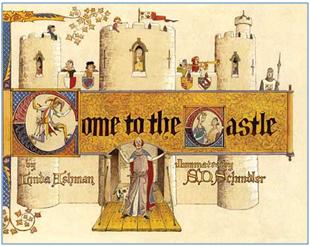Come to the Castle, by Linda Ashman, illuminated by S.D. Schindler
Tricking the Tallyman, by Jacqueline Davies, illustrated by S.D. Schindler
These two books have at least two things in common. They were both published in 2009, and they were both illustrated (illuminated) by S.D. Schindler. They’re also both entertaining and educational, each with its own wry, quirky sense of humor.
 Come to the Castle is subtitled, “A Visit to a Castle in Thirteenth-Century England.” Too often, the authors of children’s books succumb to the temptation to romanticize the middle ages. This book is decidedly realistic (if not downright un-romantic). This is not a dry reference book, but rather begins as a rhymed tale of the Earl of Daftwood and his plan to relieve his tedium with a bit of merriment – a tournament!
Come to the Castle is subtitled, “A Visit to a Castle in Thirteenth-Century England.” Too often, the authors of children’s books succumb to the temptation to romanticize the middle ages. This book is decidedly realistic (if not downright un-romantic). This is not a dry reference book, but rather begins as a rhymed tale of the Earl of Daftwood and his plan to relieve his tedium with a bit of merriment – a tournament!
Steward, plan a tournament!
Herald, find your horse!
This is the opportunity to introduce the many different servants who serve the Earl of Daftwood. Here is the Steward’s response:
Steward, plan a tournament?!
The Earl is surely daft!
Though he has countless servants,
I am vastly understaffed,
Overworked, and truly weary
Of his constant recreation
(Oh, how I’d love a nice massage
And several weeks’ vacation!).
As plans for the party progress, we are introduced to the Herald, the Lady, the Cook, the Cleaning Servant, the Gong Farmer, the Knight, the Squire, the Suitor, the Earl’s Daughter, the Jester, and the Doctor. Each of these has his or her own unique perspective on the role they play in the life of the castle and what a great feast will mean for them. The details are well researched – the author consulted several medieval historians to get all the details right. Schindler’s illustrations are delightfully detailed and entertaining. In addition to illuminated letters on each page, there are numerous small touches tucked away into nooks and corners that provide a rich visual picture of medieval life.
The publisher indicates that the text is pitched for ages 4-8, but older students up through 10 or so will also enjoy the story. This would definitely make a great read-aloud for a child sitting in a lap and gazing at the pictures.
Come to the Castle is a hardback, 40 pages and available directly from Greenleaf Press for $17.95
 Tricking the Tallyman is subtitled, The Great Census Shenanigans of 1790. It is 1790, the year of the very first U.S. Census. Phineas Bump, Assistant Marshal of the United States rides into the Vermont town of Tunbridge in order to get an accurate count for the census. But a rumor has preceded him that the purpose of the census is to assess taxes and that the more people he counts, the more money the town will have to pay in taxes. The town resolves to trick the Tallyman. Phineas is told that most of the buildings in town are abandoned. He suspects he’s being tricked, but posts his results in the town square.
Tricking the Tallyman is subtitled, The Great Census Shenanigans of 1790. It is 1790, the year of the very first U.S. Census. Phineas Bump, Assistant Marshal of the United States rides into the Vermont town of Tunbridge in order to get an accurate count for the census. But a rumor has preceded him that the purpose of the census is to assess taxes and that the more people he counts, the more money the town will have to pay in taxes. The town resolves to trick the Tallyman. Phineas is told that most of the buildings in town are abandoned. He suspects he’s being tricked, but posts his results in the town square.
The townspeople now learn that the purpose of the census is to determine how many votes Vermont should have in the new Congress. More votes would mean a better chance for a road and a post office. The townspeople ask for a recount – and attempt to trick the Tallyman yet again. Everyone gets counted twice, at least!
Phineas posts the new results, grumbles “Tis a tally not worth the paper it is written on.”
Finally the townspeople figure out the truth: the census is for taxes AND for representation in the new Congress. Phineas is persuaded to count one more time.
“We’re the town that tricked the Tallyman – twice! But then, we decided ’twas better to be fair and true. And so we were. Entirely.”
The author’s note at the end includes the six questions asked at each household during the first US Census. 650 assistant marshals were employed by Thomas Jefferson, Secretary of State to President George Washington to determine the official population of each of the states.
Once again, Schindler’s illustrations are delightful. They show us what life in a small town in the Vermont woods looked like in the 1790s. The family scenes and facial expressions are delightful. One learns a lot about colonial life just by looking at the clothes, the houses, the furniture, the toys, and especially the town scenes.
Tricking the Tallyman is also targeted to children, ages 5-8, but like Come to the Castle, the story will be interesting for students up through age 10-12. Since next year (2010) is a census year, this book is very timely, and could be used as part of a study on US History and the US Congress. Should the number of congressman from your state change? How will we know? How will the government find out?
Tricking the Tallyman is a hardback, 40 pages and available from Greenleaf Press for $17.99